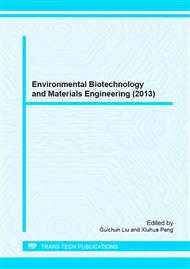[1]
A. D. Meintyre, Ecological Toxicology research effects of heavy metal and Organohalogen Compounds. Plenum Press, NewYork, (1975).
Google Scholar
[2]
Guohua Jing, Meixia Dong, Zuoming Zhou, Effects of ultrasound on adsorption and desorption of chromium(Ⅵ) on activated carbon, CIESC Journal. 60(2009) 2806-2812.
Google Scholar
[3]
L. Monser, N. Adhoum. Modified activated carbon for the removal of copper, zinc, chromium and cyanide from waste water, Separation and Purification Technology. 26(2002)137-146.
DOI: 10.1016/s1383-5866(01)00155-1
Google Scholar
[4]
C. Gabaldn, P. Marzal, J. Ferrer, et al. Single and competitive adsorption of Cd and Zn onto a granular activated carbon, J. Water Research, 30(1996)3050-3060.
DOI: 10.1016/s0043-1354(96)00165-0
Google Scholar
[5]
M.H. Entezari, T.R. Bastami, Sono-sorption as a new method for the removal of leadion from aqueous solution, Journal of Hazardous Materials. 137(2006)959-964.
DOI: 10.1016/j.jhazmat.2006.03.019
Google Scholar
[6]
C. Moreno-Castilla, J. Rivera-Utrilla, J.P. Joly. et al. Thermal regeneration of an activated carbon exhausted with different substituted phenols, Carbon. 33 (1995) 1417–1423.
DOI: 10.1016/0008-6223(95)00090-z
Google Scholar
[7]
J.E. Kilduff, C.J. King, Effect of carbon adsorbent surface properties on the uptake and solvent regeneration of phenol, Ind. Eng. Chem. Res. 36(1997)1603.
DOI: 10.1021/ie960545v
Google Scholar
[8]
H. Zhang. Regeneration of exhausted activated carbon by electrochemical method, Chem. Eng. J. 85 (2002) 81–85.
Google Scholar
[9]
Y. Nakano, L.Q. Hua, W. Nishijima, M. Okada, Biodegradation of trichloroethylene (TCE)adsorbed on granular activated carbon (GAC), Water Res. 34(2000)4139.
DOI: 10.1016/s0043-1354(00)00199-8
Google Scholar
[10]
Jae-Lim Lim, Mitsumasa Okada. Regeneration of granular activated carbon using ultrasound[J], Ultrasounds Sonochemistry, 12(2005), 277-282.
DOI: 10.1016/j.ultsonch.2004.02.003
Google Scholar
[11]
Sanfan Wang, Preliminary study on ultrasound regeneration of activiated carbon, China Water & Wastewater. 14(1998)24-26.
Google Scholar
[12]
S.U. Rege, R.T. Yang, C.A. Cain, Desorption by ultrasound: phenol on activated carbon and polymeric resin, AIChE J. 44 (1998)1519–1528.
DOI: 10.1002/aic.690440706
Google Scholar
[13]
T.J. Mason, Practical Sonochemistry: User's guide to applications in chemistry and chemical engineering, Ellis Horwood, Chichester, 1991, 186.
Google Scholar
[14]
O. Hamdaoui, E. Naffrechoux, L. Tifouti, C. Petrier, Effects of ultrasound on adsorption-desorption of p-chlorophenol on granular activated carbon, Ultrason Sonochem. 10(2003)109-114.
DOI: 10.1016/s1350-4177(02)00137-2
Google Scholar
[15]
L.H. Thompson, L.K. Doraiswamy, Sonochemistry: science and engineering, Ind. Eng. Chem. Res. 38 (1999) 1215–1249.
DOI: 10.1021/ie9804172
Google Scholar


